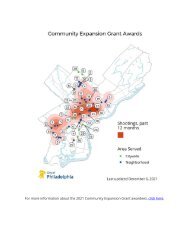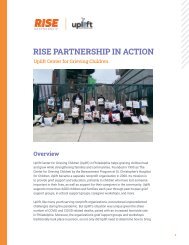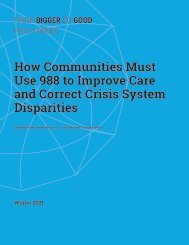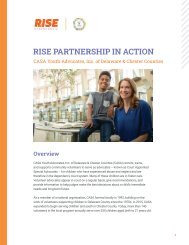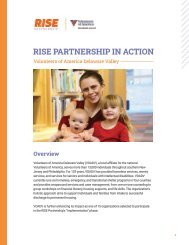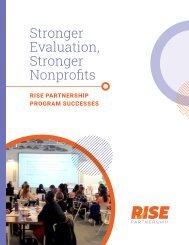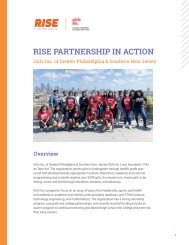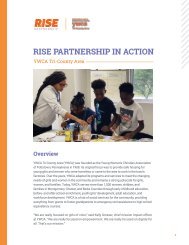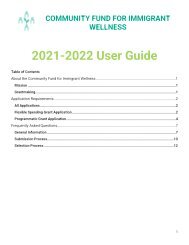How Communities Must Use 988 to Improve Care and Correct Crisis System Disparities
Create successful ePaper yourself
Turn your PDF publications into a flip-book with our unique Google optimized e-Paper software.
THINK BIGGER DO GOOD<br />
POLICY SERIES<br />
<strong>How</strong> <strong>Communities</strong> <strong>Must</strong><br />
<strong>Use</strong> <strong>988</strong> <strong>to</strong> <strong>Improve</strong> <strong>Care</strong><br />
<strong>and</strong> <strong>Correct</strong> <strong>Crisis</strong> <strong>System</strong><br />
<strong>Disparities</strong><br />
Stephanie Barrios Hepburn, J.D., <strong>and</strong> Michael F. Hogan, Ph.D.<br />
Winter 2021<br />
<strong>How</strong> <strong>Communities</strong> <strong>Must</strong> <strong>Use</strong> <strong>988</strong> <strong>to</strong> <strong>Improve</strong> <strong>Care</strong> <strong>and</strong> <strong>Correct</strong> <strong>Crisis</strong> <strong>System</strong> <strong>Disparities</strong> 1
Behavioral Health <strong>and</strong> the Individual Health Insurance Market
Dear Reader,<br />
As communities prepare for the <strong>988</strong> launch nationwide, we are prioritizing work at the local <strong>and</strong> state<br />
levels for the effective coordination of crisis response services. In partnership with national experts<br />
in behavioral health, we focus each paper on the challenge, <strong>and</strong> we hope <strong>to</strong> provide clear, actionable<br />
solutions <strong>to</strong> our audience. This paper was specifically commissioned <strong>to</strong> offer resources <strong>and</strong> serve as<br />
a <strong>to</strong>ol for communities <strong>to</strong> use in developing <strong>and</strong> enhancing call centers, mobile teams, <strong>and</strong> crisis care<br />
facilities <strong>to</strong> create better outcomes for people in crises.<br />
Now is the time <strong>to</strong> address the growing behavioral health needs in our country by advancing public<br />
policies that transform the delivery of mental health <strong>and</strong> substance use disorder services <strong>and</strong> address<br />
outdated funding mechanisms.<br />
We hope you join us in advocating for stronger behavioral health policies by sharing this paper with<br />
your programmatic partners; local, state, <strong>and</strong> federal decision makers; advocacy organizations; <strong>and</strong><br />
voters. To learn more about Think Bigger Do Good <strong>and</strong> <strong>to</strong> access the other papers in the series, visit<br />
www.thinkbiggerdogood.org.<br />
Sincerely,<br />
Joseph Pyle, M.A.<br />
President<br />
Scattergood Foundation<br />
Founding Partner of Series<br />
Rick Kellar, M.B.A.<br />
President<br />
Peg’s Foundation<br />
Founding Partner of Series<br />
Jane Mogavero, Esq.<br />
Executive Direc<strong>to</strong>r<br />
Patrick P. Lee Foundation<br />
Tracy A. Sawicki<br />
Executive Direc<strong>to</strong>r<br />
Peter & Elizabeth Tower Foundation<br />
We would like <strong>to</strong> acknowledge Andrea L. Dennis, John Byrd Martin Chair of Law, University of<br />
Georgia School of Law <strong>and</strong> Mark R. Munetz, MD, Professor <strong>and</strong> Chair, Emeritus, Department of<br />
Psychiatry, Northeast Ohio Medical University as reviewers of this paper <strong>and</strong> thank them for<br />
their helpful comments.<br />
<strong>How</strong> <strong>Communities</strong> <strong>Must</strong> <strong>Use</strong> <strong>988</strong> <strong>to</strong> <strong>Improve</strong> <strong>Care</strong> <strong>and</strong> <strong>Correct</strong> <strong>Crisis</strong> <strong>System</strong> <strong>Disparities</strong> 3
We would like <strong>to</strong> acknowledge the following individuals for their participation in<br />
the meeting that led <strong>to</strong> the conceptualization of the paper series.<br />
Colleen L. Barry, Ph.D., M.P.P.<br />
John Hopkins Bloomberg School of<br />
Public Health<br />
Cynthia Baum-Baicker, Ph.D.<br />
The Scattergood Foundation<br />
Anita Burgos, Ph.D.<br />
Bipartisan Policy Center<br />
Thom Craig, M.P.A.<br />
Peg’s Foundation<br />
Rebecca David, M.P.H.<br />
National Council for Behavioral Health<br />
Kelly Davis<br />
Mental Health America<br />
Lisa Dixon, M.D., M.P.H.<br />
Columbia University, NY State Psychiatric<br />
Institute, <strong>and</strong> Psychiatric Services<br />
Sara Dugan, Pharm.D., B.C.P.P., B.C.P.S.<br />
Northeast Ohio Medical University<br />
Peter Earley<br />
Author & Journalist<br />
Alyson Ferguson, M.P.H.<br />
The Scattergood Foundation<br />
Richard Frank, Ph.D.<br />
Harvard Medical School<br />
Rachel Garfield, Ph.D., M.H.S.<br />
The Henry J. Kaiser Family Foundation<br />
Mary Giliberti, J.D.<br />
Mental Health America<br />
Aaron Glickman, B.A.<br />
Perelman School of Medicine,<br />
University of Pennsylvania<br />
Sherry Glied, Ph.D.<br />
NYU Wagner School of Public Service<br />
<strong>How</strong>ard Goldman, M.D., Ph.D.<br />
University of Maryl<strong>and</strong> School<br />
of Medicine<br />
Pamela Greenberg, M.P.P.<br />
Association for Behavioral Health<br />
<strong>and</strong> Wellness<br />
Kimberly Hoagwood, Ph.D.<br />
New York University School of Medicine<br />
Michael F. Hogan, Ph.D.<br />
Hogan Health Solutions<br />
Chuck Ingoglia, M.S.W.<br />
National Council for Behavioral Health<br />
Rick Kellar, M.B.A.<br />
Peg’s Foundation<br />
Kelly Kelleher, M.D., M.P.H.<br />
The Research Institute at Nationwide<br />
Children’s Hospital<br />
Jennifer Mathis, J.D.<br />
Bazelon Center for Mental Health Law<br />
Donald Matteson, M.A.<br />
Pete & Elizabeth Tower Foundation<br />
Brian McGregor, Ph.D.<br />
Satcher Health Leadership Institute,<br />
Morehouse College<br />
Erik Messamore, M.D.<br />
Northeast Ohio Medical University<br />
Ben Miller, Psy.D.<br />
Well Being Trust<br />
Jane Mogavero, Esq.<br />
Patrick P. Lee Foundation<br />
Mark R. Munetz, M.D.<br />
Northeast Ohio Medical University<br />
S<strong>and</strong>ra Newman, Ph.D.<br />
John Hopkins Bloomberg School of<br />
Public Health<br />
Joseph Pyle, M.A.<br />
The Scattergood Foundation<br />
Barbara Ricci<br />
Center for High Impact Philanthropy<br />
Cheryl Roberts, Esq.<br />
Greenberger Center<br />
Vic<strong>to</strong>ria Rom<strong>and</strong>a<br />
Peg’s Foundation<br />
Tracy A. Sawicki<br />
Peter & Elizabeth Tower Foundation<br />
Lloyd Sederer, M.D.<br />
NYS Office of Mental Health/Mailman<br />
School of Public Health<br />
Dominic Sisti, Ph.D.<br />
Scattergood Program for Applied Ethics<br />
in Behavioral Health <strong>Care</strong> & Perelman<br />
School of Medicine at the University<br />
of Pennsylvania<br />
Andrew Sperling, J.D.<br />
NAMI<br />
Kate Williams, J.D.<br />
The Scattergood Foundation<br />
Glenda L. Wrenn, M.D., M.S.H.P.<br />
180 Health Partners<br />
<strong>How</strong> <strong>Communities</strong> <strong>Must</strong> <strong>Use</strong> <strong>988</strong> <strong>to</strong> <strong>Improve</strong> <strong>Care</strong> <strong>and</strong> <strong>Correct</strong> <strong>Crisis</strong> <strong>System</strong> <strong>Disparities</strong> 4
Titles in the Paper Series<br />
Edi<strong>to</strong>rs <strong>How</strong>ard Goldman, M.D., Ph.D., <strong>and</strong> Constance Gartner, M.S.W.<br />
America’s Opioid Epidemic<br />
Lloyd I. Sederer, M.D.<br />
Behavioral Health <strong>and</strong> the Individual Health Insurance Market: Preserving Key Elements of Reform<br />
Richard G. Frank, Ph.D., <strong>and</strong> Sherry A. Glied, Ph.D., M.A.<br />
Bringing Treatment Parity <strong>to</strong> Jail Inmates with Schizophrenia<br />
Mark R. Munetz, M.D., Erik Messamore, M.D., Ph.D., <strong>and</strong> Sara E. Dugan, Pharm.D., B.C.P.P., B.C.P.S.<br />
Coordinated Specialty <strong>Care</strong> for First-Episode Psychosis: An Example of Financing for Specialty Programs<br />
Lisa B. Dixon, M.D., M.P.H.<br />
COVID-19, Structural Racism, <strong>and</strong> Mental Health Inequities: Policy Implications for an Emerging Syndemic<br />
Ruth S. Shim, M.D., M.P.H., <strong>and</strong> Steven M. Starks, M.D.<br />
Employing People with Mental Illness in the 21st Century: Labor Market Changes <strong>and</strong> Policy Challenges<br />
Richard G. Frank, Ph.D., <strong>and</strong> Sherry A. Glied, Ph.D., M.A.<br />
Fentanyl <strong>and</strong> the Evolving Opioid Epidemic: What Strategies Should Policymakers Consider?<br />
Colleen L. Barry, Ph.D., M.P.P.<br />
Housing Is Mental Health <strong>Care</strong>: A Call for Medicaid Demonstration Waivers Covering Housing<br />
Jennifer Mathis, J.D.<br />
Improving Outcomes for People with Serious Mental Illness <strong>and</strong> Co-Occurring Substance <strong>Use</strong> Disorders in Contact<br />
with the Criminal Justice <strong>System</strong><br />
Glenda L. Wrenn, M.D., M.S.H.P., Brian McGregor, Ph.D., <strong>and</strong> Mark R. Munetz, M.D.<br />
Informed Consent: A Policy Prescription for Communicating Benefit <strong>and</strong> Risk in State Medical Marijuana Programs<br />
Erik Messamore, M.D., Ph.D., <strong>and</strong> Sara E. Dugan, Pharm.D., B.C.P.P., B.C.P.S.<br />
Integrating Mental Health <strong>and</strong> Addiction Treatment in General Medical <strong>Care</strong>: The Role of Policy<br />
Emma B. McGinty, Ph.D., M.S., <strong>and</strong> Gail L. Daumit, M.D., M.H.S.<br />
Medicaid’s Institutions for Mental Diseases (IMD) Exclusion Rule: A Policy Debate<br />
Jennifer Mathis, J.D., Dominic A. Sisti, Ph.D., <strong>and</strong> Aaron Glickman, B.A.<br />
Meeting the Needs of Justice-Involved People with Serious Mental Illness within Community<br />
Behavioral Health <strong>System</strong>s<br />
Natalie Bonfine, Ph.D., Amy Blank Wilson, Ph.D., L.S.W., <strong>and</strong> Mark R. Munetz, M.D.<br />
New Opportunities <strong>to</strong> <strong>Improve</strong> Mental Health <strong>Crisis</strong> <strong>System</strong>s<br />
Michael F. Hogan, Ph.D., <strong>and</strong> Mathew L. Goldman, M.D., M.S.<br />
Redesigning Federal Health Insurance Policies <strong>to</strong> Promote Children’s Mental Health<br />
Kimberly Hoagwood, Ph.D., Kelly Kelleher, M.D., M.P.H., <strong>and</strong> Michael F. Hogan, Ph.D.<br />
<strong>How</strong> <strong>Communities</strong> <strong>Must</strong> <strong>Use</strong> <strong>988</strong> <strong>to</strong> <strong>Improve</strong> <strong>Care</strong> <strong>and</strong> <strong>Correct</strong> <strong>Crisis</strong> <strong>System</strong> <strong>Disparities</strong> 5
Policy <strong>and</strong> Practice Innovations <strong>to</strong> <strong>Improve</strong> Prescribing of Psychoactive Medications for Children<br />
Kelly J. Kelleher, M.D., M.P.H., David Rubin, M.D., M.S.C.E., <strong>and</strong> Kimberly Hoagwood, Ph.D.<br />
Policy Recommendations <strong>to</strong> Address Housing Shortages for People with Severe Mental Illness<br />
Sally Luken, M.A.<br />
Preventing Risk <strong>and</strong> Promoting Young Children’s Mental, Emotional, <strong>and</strong> Behavioral Health<br />
in State Mental Health <strong>System</strong>s<br />
Kimberly Ea<strong>to</strong>n Hoagwood, Ph.D., Kelly Kelleher, M.D., Nathaniel Z. Counts, J.D., Suzanne Brundage, M.Sc., <strong>and</strong> Robin<br />
Peth-Pierce, M.P.A.<br />
Preventing Suicide Through Better Firearm Safety Policy in the United States<br />
Jeffrey W. Swanson, Ph.D.<br />
<strong>System</strong>ic, Racial Justice–Informed Solutions <strong>to</strong> Shift “<strong>Care</strong>” From the Criminal Legal <strong>System</strong> <strong>to</strong> the<br />
Mental Health <strong>Care</strong> <strong>System</strong><br />
Sarah Y. Vinson, M.D., <strong>and</strong> Andrea L. Dennis, J.D.<br />
Suicide Is a Significant Health Problem<br />
Michael F. Hogan, Ph.D.<br />
The Current Medicaid Policy Debate <strong>and</strong> Implications for Behavioral Healthcare in the United States<br />
Rachel Garfield, Ph.D., M.H.S., <strong>and</strong> Julia Zur, Ph.D.<br />
Youth Suicide Is Increasing: Modest Actions Taken Now Can Save Lives<br />
Michael F. Hogan, Ph.D.<br />
Find the papers online at www.thinkbiggerdogood.org<br />
We are grateful for the partnership that allows papers in this series <strong>to</strong> appear in<br />
Psychiatric Services, a peer-reviewed monthly journal of the American Psychiatric<br />
Association. Content can be viewed at ps.psychiatryonline.org.<br />
<strong>How</strong> <strong>Communities</strong> <strong>Must</strong> <strong>Use</strong> <strong>988</strong> <strong>to</strong> <strong>Improve</strong> <strong>Care</strong> <strong>and</strong> <strong>Correct</strong> <strong>Crisis</strong> <strong>System</strong> <strong>Disparities</strong> 6
<strong>How</strong> <strong>Communities</strong><br />
<strong>Must</strong> <strong>Use</strong> <strong>988</strong><br />
<strong>to</strong> <strong>Improve</strong> <strong>Care</strong><br />
<strong>and</strong> <strong>Correct</strong> <strong>Crisis</strong><br />
<strong>System</strong> <strong>Disparities</strong><br />
Stephanie Barrios Hepburn, J.D.<br />
Chief Content Officer, RI International<br />
Edi<strong>to</strong>r in Chief, #<strong>Crisis</strong>Talk<br />
stephanie.hepburn@riinternational.com<br />
Michael F. Hogan, Ph.D.<br />
Department of Psychiatry<br />
Case Western Reserve<br />
dr.m.hogan@gmail.com<br />
<strong>How</strong> <strong>Communities</strong> <strong>Must</strong> <strong>Use</strong> <strong>988</strong> <strong>to</strong> <strong>Improve</strong> <strong>Care</strong> <strong>and</strong> <strong>Correct</strong> <strong>Crisis</strong> <strong>System</strong> <strong>Disparities</strong> 7
1<br />
<strong>988</strong>: A New Opportunity<br />
Most people cannot remember a time before 911, when people in an emergency dialed 0 for<br />
an opera<strong>to</strong>r or directly called or ran <strong>to</strong> the nearest police or fire station. For years, behavioral<br />
health 1 advocates <strong>and</strong> experts have pushed for a three-digit number for mental health,<br />
substance use, <strong>and</strong> suicide crises—a number that would be on par with <strong>and</strong>, hopefully, as<br />
ubiqui<strong>to</strong>us as 911 is for medical emergencies. And, like 911, the innovation wouldn’t be just a<br />
number. Instead, experts envisioned a well-funded, interconnected emergency system for<br />
behavioral health crises, with a continuum of services <strong>and</strong> supports that would help foster<br />
parity while reducing stigma <strong>and</strong> criminalization.<br />
The United States <strong>to</strong>ok a vital step <strong>to</strong>ward this goal in July 2020, when Federal<br />
Communications Commission (FCC) Chairperson Ajit Pai (1) announced a nationwide threedigit<br />
number that would “effectively establish ‘<strong>988</strong>’ as the ‘911’ for mental health emergencies.”<br />
Under Pai’s guidance, the FCC adopted rules requiring all phone service carriers <strong>to</strong> direct<br />
<strong>988</strong> calls by July 16, 2022, <strong>to</strong> the existing National Suicide Prevention Lifeline (2), which the<br />
Substance Abuse <strong>and</strong> Mental Health Services Administration (SAMHSA) funds. The Lifeline,<br />
run by Vibrant Emotional Health, is a network of about 200 2 accredited call centers. All<br />
<strong>988</strong> calls—<strong>and</strong>, potentially, texts—will go <strong>to</strong> the centers, filtered by area code unless callers<br />
press 1 <strong>to</strong> reach the Veterans <strong>Crisis</strong> Line, the national crisis call system operated by the<br />
Department of Veterans Affairs. Three months after Pai’s announcement, Congress passed<br />
the National Suicide Hotline Designation Act of 2020 (3), supporting <strong>988</strong> implementation<br />
<strong>and</strong> allowing states <strong>to</strong> apply a monthly telecom cus<strong>to</strong>mer service fee <strong>to</strong> pay for <strong>988</strong>-related<br />
services. Many communities across the United States, increasingly aware of gaps in the<br />
overall crisis response continuum, had already started or planned <strong>to</strong> re-engineer <strong>and</strong> build<br />
out their systems, including mobile crisis services <strong>and</strong> crisis facilities. Expansion plans have<br />
also included the evolution of crisis call centers in<strong>to</strong> hubs that can dispatch mobile crisis<br />
teams <strong>and</strong> provide real-time data on <strong>and</strong> access <strong>to</strong> crisis facilities. As states move <strong>to</strong>ward <strong>988</strong><br />
readiness, communities must capitalize on this momentum <strong>to</strong> meet local needs.<br />
This paper describes examples <strong>and</strong> new resources <strong>to</strong> improve the care of people experiencing<br />
behavioral health crises. We focus on imminent opportunities <strong>and</strong> provide links <strong>to</strong> resources<br />
helpful in regional or local crisis redesign efforts.<br />
1<br />
The term behavioral health has evolved <strong>to</strong> include both mental <strong>and</strong> substance use disorders.<br />
2<br />
As of November 2021, there were 194 Lifeline accredited call centers, with seven more in the final onboarding phase.<br />
<strong>How</strong> <strong>Communities</strong> <strong>Must</strong> <strong>Use</strong> <strong>988</strong> <strong>to</strong> <strong>Improve</strong> <strong>Care</strong> <strong>and</strong> <strong>Correct</strong> <strong>Crisis</strong> <strong>System</strong> <strong>Disparities</strong> 8
2<br />
Change the Culture<br />
In recent years, crisis care reform has exp<strong>and</strong>ed <strong>to</strong> include not only addressing<br />
long-st<strong>and</strong>ing problems in providing appropriate care <strong>to</strong> people in mental health<br />
crises but also ensuring that people experiencing substance use crises receive<br />
such care. This exp<strong>and</strong>ed framework for reform has been accompanied by greater<br />
recognition of inequities associated with reliance on law enforcement as the de<br />
fac<strong>to</strong> responder for behavioral health <strong>and</strong> quality-of-life crises. Tools such as the<br />
Sequential Intercept Model, developed by Munetz <strong>and</strong> Griffin (4), <strong>and</strong> resources<br />
promoted by SAMHSA’s GAINS Center, as well as Stepping Up (5), a national<br />
initiative <strong>to</strong> reduce the number of people with mental illness in jails, have helped<br />
advance this cause. <strong>How</strong>ever, a confluence of fac<strong>to</strong>rs has magnified the need<br />
for change, including the COVID p<strong>and</strong>emic <strong>and</strong> increased awareness of racial<br />
<strong>and</strong> ethnic disparities in law enforcement interactions brought in<strong>to</strong> focus by the<br />
murder of George Floyd by four Minneapolis police officers in May 2020.<br />
As a result, leaders have leaned further in<strong>to</strong> finding alternatives <strong>to</strong> justice system<br />
entanglement for people with behavioral health <strong>and</strong> quality-of-life challenges<br />
<strong>and</strong> reforming crisis systems <strong>to</strong> better meet people’s needs. This is especially<br />
vital for supporting marginalized <strong>and</strong> disenfranchised populations, who are<br />
disproportionately most at risk of police interactions turning deadly (6). According<br />
<strong>to</strong> November 2021 data from the Washing<strong>to</strong>n Post’s police shooting database (7),<br />
of people killed in the United States by a police officer in the line of duty since<br />
January 1, 2015, 23% were Black, 16% were Hispanic, <strong>and</strong> 23% were identified as<br />
having a mental illness. These populations are also more at risk of incarceration.<br />
For example, in Harris County, Texas, the Sheriff’s Department maintains a jail<br />
“dashboard” that gives information on each inmate (8). On November 13, 2021,<br />
Black <strong>and</strong> Hispanic people disproportionately made up the jail population—51%<br />
<strong>and</strong> 24%, respectively. The majority of inmates, 77%, were experiencing mental<br />
health challenges, <strong>and</strong> roughly 86% were in pretrial detention, meaning that they<br />
were in jail awaiting due process. Ed Gonzalez, Harris County Sheriff, <strong>to</strong>ld the<br />
Texas St<strong>and</strong>ard that the county’s jail is “the largest mental health facility in the<br />
state” (9).<br />
<strong>How</strong> <strong>Communities</strong> <strong>Must</strong> <strong>Use</strong> <strong>988</strong> <strong>to</strong> <strong>Improve</strong> <strong>Care</strong> <strong>and</strong> <strong>Correct</strong> <strong>Crisis</strong> <strong>System</strong> <strong>Disparities</strong> 9
Box 1 / High-Leverage Opportunities <strong>to</strong> <strong>Improve</strong> <strong>Crisis</strong> <strong>Care</strong> in Your Community<br />
1<br />
2<br />
3<br />
4<br />
Work <strong>to</strong> divert 911 calls<br />
Help your <strong>988</strong> call center<br />
Bring stakeholders<br />
Develop your marketing<br />
from PSAPs <strong>to</strong> your<br />
“upgrade” <strong>to</strong> a crisis care<br />
<strong>to</strong>gether <strong>to</strong> plan for a<br />
plan. Most states plan <strong>to</strong><br />
region’s <strong>988</strong> call center.<br />
hub with the ability <strong>to</strong><br />
regional crisis receiving<br />
slowly roll out <strong>988</strong>, not<br />
An incremental, staged<br />
dispatch mobile teams <strong>and</strong><br />
facility that will accept<br />
simply flip a switch on<br />
approach may be best,<br />
maintain real-time data on<br />
direct drop-offs from first<br />
July 16, 2022. <strong>How</strong>ever,<br />
such as starting with<br />
crisis services access.<br />
responders <strong>and</strong> bypass<br />
states are beginning <strong>to</strong><br />
physical or virtual co-<br />
overloaded emergency<br />
develop their marketing<br />
location of behavioral<br />
departments.<br />
plan, with some, such<br />
health crisis professionals<br />
as Georgia, hiring a<br />
at 911 call centers.<br />
consulting firm <strong>to</strong> h<strong>and</strong>le<br />
their <strong>988</strong> communications.<br />
<strong>Crisis</strong> <strong>Care</strong> Services Shouldn’t Come in a Police Car<br />
As communities across the nation debate the role of police<br />
<strong>and</strong> explore alternative response programs, Ron Bruno, a<br />
retired Utah police officer <strong>and</strong> executive direc<strong>to</strong>r at <strong>Crisis</strong><br />
Intervention Team (CIT) International (10), has pointed out<br />
that while police have a critical role in mental health crisis<br />
response, it is in the position of support <strong>and</strong> only when<br />
necessary. He notes, “We have <strong>to</strong> challenge the belief that<br />
mental health crisis services must come in a police car” (11).<br />
According <strong>to</strong> Bruno, most calls <strong>to</strong> 911 don’t require a police<br />
response, <strong>and</strong> call takers can transfer calls <strong>to</strong> a crisis line<br />
where “the majority of calls, 80% <strong>and</strong> upward, are resolved<br />
at that level, <strong>and</strong> there’s no need for police involvement.”<br />
The CIT program, developed by now-retired Memphis Police<br />
Maj. Sam Cochran, is a first-responder, police-based crisis<br />
intervention designed <strong>to</strong> reduce the role of law enforcement<br />
in behavioral health crisis response. The program in Memphis<br />
was one of the earliest <strong>and</strong> most critical innovations <strong>to</strong><br />
address the criminalization of mental health, <strong>and</strong> it was<br />
sparked by a lethal police interaction that <strong>to</strong>ok place more<br />
than three decades ago. In 1987, police officers in Memphis<br />
responded <strong>to</strong> a 911 call from a mother worried her son would<br />
kill himself (12). Joseph DeWayne Robinson had cut himself<br />
120 times with a butcher’s knife. He had schizophrenia <strong>and</strong><br />
was experiencing paranoia. When police officers arrived at<br />
LeMoyne Gardens public housing project, the perimeter was<br />
tight, <strong>and</strong> they asked Robinson <strong>to</strong> drop the knife. He didn’t.<br />
The officers shot <strong>and</strong> killed him. They said Robinson lunged<br />
at them, but witnesses said he did not. The killing resulted in<br />
community outrage <strong>and</strong> prompted racial bias charges against<br />
the city’s administration. Robinson was Black, <strong>and</strong> the two<br />
officers were White.<br />
Following the police killing of Robinson, Maj. Cochran led a<br />
diverse stakeholder effort <strong>and</strong> law enforcement commitment<br />
<strong>to</strong> develop teams specially trained <strong>to</strong> work with people in a<br />
mental health or substance use crisis. <strong>How</strong>ever, although<br />
many communities have emphasized the police training<br />
approach, they have often focused less on another core<br />
component of the model: community partnership between<br />
law enforcement, behavioral health, people with lived<br />
expertise, <strong>and</strong> other advocates. Maj. Cochran has said that the<br />
platform is designed, through robust collaboration, <strong>to</strong> remove<br />
system barriers that prevent people with mental illness from<br />
getting the help they need (13). That includes ensuring that<br />
there are crisis facilities where law enforcement can, obstaclefree,<br />
take people in distress for care—instead of booking <strong>and</strong><br />
cus<strong>to</strong>dy. These facilities are an essential component of a<br />
comprehensive behavioral health crisis system that continues<br />
<strong>to</strong> be absent in many communities.<br />
<strong>How</strong> <strong>Communities</strong> <strong>Must</strong> <strong>Use</strong> <strong>988</strong> <strong>to</strong> <strong>Improve</strong> <strong>Care</strong> <strong>and</strong> <strong>Correct</strong> <strong>Crisis</strong> <strong>System</strong> <strong>Disparities</strong> 10
The Council of State Governments’ Justice <strong>and</strong> Mental Health<br />
Collaboration Program also fosters partnership between<br />
criminal justice <strong>and</strong> behavioral health systems (14). Integrated<br />
in<strong>to</strong> the program are 14 peer-<strong>to</strong>-peer learning sites that have<br />
demonstrated best practices when responding <strong>to</strong> behavioral<br />
health issues <strong>and</strong> houselessness. Linking crisis systems,<br />
starting with 911, should be a primary target for communities<br />
as they plan <strong>988</strong> implementation. Less examined, but also<br />
vital, is how <strong>988</strong> will connect <strong>to</strong> social service numbers for<br />
people experiencing quality-of-life challenges—sometimes<br />
311 or 211, depending on the community—<strong>to</strong> ensure linkage<br />
beyond “a warm h<strong>and</strong>off.”<br />
Link <strong>and</strong> Partner with Intersecting <strong>System</strong>s<br />
His<strong>to</strong>rically, states <strong>and</strong> counties have developed behavioral<br />
health crisis systems without input from the community<br />
<strong>and</strong> essential partners <strong>and</strong> then expected them <strong>to</strong> fall in<br />
line. To ensure that system reform does not repeat the<br />
same mistakes, partnership <strong>and</strong> cooperation must be part<br />
of the <strong>988</strong> system’s development at every step of planning<br />
<strong>and</strong> implementation. That doesn’t mean considering only<br />
the populations a system serves, but instead convening<br />
a work group that includes these populations along with<br />
other stakeholders—law enforcement, hospitals <strong>and</strong><br />
emergency departments, state <strong>and</strong> local behavioral health<br />
officials, Lifeline-<strong>988</strong> call centers, judges, prosecu<strong>to</strong>rs,<br />
public defenders, social workers, peers, advocates, <strong>and</strong><br />
representatives from city, county, <strong>and</strong> state agencies.<br />
Using a community strategic planning <strong>to</strong>ol <strong>to</strong> inform its<br />
recommendations, the work group should track how people<br />
with behavioral health <strong>and</strong> quality-of-life challenges<br />
come in<strong>to</strong> contact <strong>and</strong> move through the criminal justice<br />
system. For example, the Sequential Intercept Model does<br />
just that at critical intercept points: community services,<br />
law enforcement, initial court hearings <strong>and</strong> detention,<br />
jails <strong>and</strong> courts, reentry, <strong>and</strong> community corrections (15).<br />
<strong>Communities</strong>, such as Los Angeles County, have used a<br />
modified version of the model (16), which adds intercept<br />
00 (17), focusing on a holistic, community-based, systemof-care<br />
infrastructure <strong>and</strong> recommendations <strong>to</strong> prevent<br />
justice system involvement <strong>and</strong> for community reentry<br />
after incarceration. In addition, many communities already<br />
have cross-system <strong>and</strong> consumer-family representation<br />
work groups <strong>and</strong> collaborations through participation in<br />
the previously mentioned Stepping Up initiative, a national<br />
effort sponsored by the Council of State Governments (5).<br />
The initiative has four key jail diversion measures for people<br />
with mental illness: reduce the number of people booked<br />
in<strong>to</strong> jail, shorten their average length of stay, increase their<br />
connections <strong>to</strong> treatment, <strong>and</strong> lower recidivism rates. Other<br />
communities are turning <strong>to</strong> their CIT steering committees,<br />
which seek <strong>to</strong> grow the program’s efforts beyond police<br />
training <strong>and</strong> <strong>to</strong>ward a more systematic approach. Some<br />
communities are doing all three. These efforts provide a<br />
strong launching pad for implementing <strong>988</strong> <strong>to</strong> strengthen<br />
crisis response.<br />
<strong>How</strong> <strong>Communities</strong> <strong>Must</strong> <strong>Use</strong> <strong>988</strong> <strong>to</strong> <strong>Improve</strong> <strong>Care</strong> <strong>and</strong> <strong>Correct</strong> <strong>Crisis</strong> <strong>System</strong> <strong>Disparities</strong> 11
3<br />
<strong>988</strong>-911 Partnership:<br />
Crack Open the<br />
911 “Black Box”<br />
What has led <strong>to</strong> the high involvement of police in psychiatric <strong>and</strong> quality-of-life crises<br />
is multifold <strong>and</strong> based on precedent, expectation, <strong>and</strong> the vast underfunding <strong>and</strong><br />
insufficient reimbursement of behavioral health <strong>and</strong> community-based services. Police<br />
also become involved because 911 is an easy-<strong>to</strong>-remember number that people know<br />
<strong>to</strong> call in an emergency, <strong>and</strong> public-safety answering points (PSAPs)—such as 911 call<br />
centers—are GPS-enabled, allowing first responders <strong>to</strong> respond quickly. Although 911<br />
is the number people dial <strong>to</strong> reach police, fire, <strong>and</strong> emergency medical services, it has<br />
long been the number people call expecting a law enforcement response, even when<br />
the call is nonemergency <strong>and</strong> there has been no crime. In fact, when 911 launched in<br />
New York City on July 1, 1968, calls for a law enforcement response spiked by over 40%<br />
(going from 12,000 <strong>to</strong> 17,000 calls a day [18])—<strong>and</strong> more than half were nonemergency<br />
(19). Years later, a study analyzed 1977 data from over 26,000 911 calls <strong>to</strong> police in<br />
Rochester, St. Louis, <strong>and</strong> Tampa-St. Petersburg (20). The researchers found that most<br />
calls were for nonemergencies. Less than 20% were for what callers perceived <strong>to</strong><br />
be criminal incidents of any kind. Yet callers continue <strong>to</strong> depend on an in-person<br />
police response.<br />
Many 911 callers are not people in a behavioral health crisis themselves, but instead<br />
they are third-party callers reporting “strange behavior.” This dynamic creates a system<br />
ripe for blind spots because of its dependence on an observer, a viewpoint easily<br />
influenced by a person’s biases, <strong>to</strong> identify what another person might be experiencing.<br />
Dr. Rebecca Neusteter, executive direc<strong>to</strong>r at University of Chicago Health Lab <strong>and</strong><br />
former policing program direc<strong>to</strong>r at the Vera Institute of Justice, has said that the<br />
nature of the 911 call taker role is “<strong>to</strong> hear one person’s perspective of a situation <strong>and</strong><br />
treat it as though it’s true” (19). An analysis of more than 18 months of 911 call data in<br />
Austin, Texas—roughly one million calls—revealed that 64% of mental health–related<br />
calls originated from disturbance <strong>and</strong> trespassing incidents <strong>and</strong> requests for welfare<br />
checks on people (21). A similar study in Atlanta found that of 3.4 million 911 calls<br />
in the metropolitan area over 3.8 years, 600,000 calls (18.4%) may have been suitable<br />
for diversion from 911 (22). The researchers labeled these calls “calls of focus.” Most<br />
<strong>How</strong> <strong>Communities</strong> <strong>Must</strong> <strong>Use</strong> <strong>988</strong> <strong>to</strong> <strong>Improve</strong> <strong>Care</strong> <strong>and</strong> <strong>Correct</strong> <strong>Crisis</strong> <strong>System</strong> <strong>Disparities</strong> 12
were coded as “suspicious person,” “directed patrol,” “criminal<br />
trespass,” “street/sidewalk hazard,” “person injured/down,”<br />
“demented person,” or “public indecency.” None were coded<br />
as mental or behavioral health. Also, a multicity 911 analysis<br />
conducted by Dr. Neusteter <strong>and</strong> her former colleagues at the<br />
Vera Institute of Justice revealed that call takers were unlikely<br />
<strong>to</strong> classify calls the same way (23). The lack of uniformity<br />
<strong>and</strong> transparency of 911 pro<strong>to</strong>cols <strong>and</strong> the local nature of 911<br />
PSAPs make it challenging <strong>to</strong> divert people experiencing<br />
mental health, substance use, or quality-of-life crises.<br />
It is likely, at least in part, that because of the obscurity of<br />
911 call coding, criminal justice diversion has primarily<br />
focused on pre-arrest diversion as the starting point, with<br />
communities turning <strong>to</strong> co-responder models (teams that<br />
comprise a police officer or emergency medical technician<br />
partnered with a behavioral health professional) <strong>and</strong><br />
alternative street responder teams. <strong>How</strong>ever, diverting people<br />
experiencing behavioral health or quality-of-life crises from a<br />
law enforcement response requires underst<strong>and</strong>ing what leads<br />
<strong>to</strong> police involvement in the first place, which often happens<br />
at the 911 call center, making it dire that communities crack<br />
open their 911 “black box” (23). With a 911-<strong>988</strong> partnership,<br />
calls <strong>to</strong> 911 can be diverted <strong>to</strong> <strong>988</strong>, <strong>and</strong> crisis resources—such<br />
as mobile crisis teams—can be dispatched instead of police<br />
officers. Los Angeles, Harris County, Austin, <strong>and</strong> Tucson are<br />
already working <strong>to</strong> improve linkages between their local 911<br />
PSAPs <strong>and</strong> behavioral health crisis call centers. Sometimes<br />
that includes physical or virtual co-location of call counselors<br />
at 911 call centers, who are integrated in<strong>to</strong> the PSAP<br />
computer-aided dispatch system, commonly called CAD.<br />
For example, in Austin, Integral <strong>Care</strong>’s Exp<strong>and</strong>ed Mobile<br />
<strong>Crisis</strong> Outreach Team (EMCOT) clinicians are physically<br />
co-located at the Combined Transportation, Emergency, <strong>and</strong><br />
Communications Center/Austin Police Department 911 Call<br />
Center <strong>and</strong> work on the same platform (24). When a person<br />
dials 911, the call taker asks, “Are you calling for police, fire,<br />
EMS, or mental health services?” The integration allows<br />
call counselors <strong>to</strong> see incoming calls <strong>and</strong> identify those<br />
with a behavioral health nexus that they can divert. Before<br />
integration with the 911 center’s communication system,<br />
Marisa Aguilar, the EMCOT’s program manager, said call<br />
takers were transferring calls over <strong>to</strong> the service by phone,<br />
<strong>and</strong> “most calls were getting dropped” (24). Since co-location,<br />
the Austin program has diverted roughly 85.4% of behavioral<br />
health calls from law enforcement <strong>and</strong> transferred them <strong>to</strong><br />
their EMCOT clinicians (25).<br />
Physical co-location of call counselors at a 911 PSAP, such<br />
as in Harris County, Texas, helps bridge the gap between<br />
two very different disciplines as they develop trust through<br />
partnership, continued communication, <strong>and</strong> a streamlined<br />
feedback loop. The Harris County program also includes<br />
dedicated mobile teams <strong>to</strong> respond <strong>to</strong> diverted 911 calls (26).<br />
<strong>How</strong>ever, physical co-location is not an option everywhere,<br />
especially in rural communities <strong>and</strong> those with a high<br />
number of PSAPs. Los Angeles County, for instance, has 78<br />
primary 911 PSAPs. Although county leaders plan <strong>to</strong> co-locate<br />
their <strong>988</strong> call center with the local PSAPs (27), they will do so<br />
virtually (28).<br />
In Tucson, the COVID p<strong>and</strong>emic forced call counselors <strong>to</strong><br />
shift <strong>to</strong> virtual co-location temporarily. <strong>How</strong>ever, it created an<br />
opportunity for more call takers. <strong>Crisis</strong> line leads in Tucson<br />
are now trained <strong>to</strong> pick up calls from the Public Safety<br />
Communications Department if the two crisis professionals<br />
trained on the CAD dispatch system are already on 911 calls.<br />
The diversion program plans <strong>to</strong> increase the number of call<br />
takers on the crisis line who are CAD-trained so it can take<br />
on even more 911 calls <strong>and</strong> is actively looking <strong>to</strong> exp<strong>and</strong> its<br />
virtual co-location <strong>to</strong> other 911 PSAPs in Arizona. During<br />
the p<strong>and</strong>emic, the stabilization rate after a dispatched<br />
Community Bridges or Community Health Associates mobile<br />
crisis team has interfaced with a person in crisis has hovered<br />
around 85%, regardless of whether the person called 911 or the<br />
crisis line (29). <strong>How</strong>ever, more 911 calls—roughly 60% of the<br />
911 calls that the team diverts—result in a mobile crisis<br />
team dispatch. When people dial 911, they expect an inperson<br />
response.<br />
<strong>How</strong> <strong>Communities</strong> <strong>Must</strong> <strong>Use</strong> <strong>988</strong> <strong>to</strong> <strong>Improve</strong> <strong>Care</strong> <strong>and</strong> <strong>Correct</strong> <strong>Crisis</strong> <strong>System</strong> <strong>Disparities</strong> 13
4<br />
Build a Comprehensive<br />
<strong>Crisis</strong> Continuum<br />
Designing a robust <strong>988</strong>-911 partnership can be maximized only if there is a<br />
reliable corresponding behavioral health crisis system <strong>to</strong> which first responders<br />
can divert people. <strong>How</strong>ever, this is not the case in many communities. When<br />
law enforcement does reach out <strong>to</strong> crisis care providers, they often experience<br />
inconsistent mobile crisis unit response or get tangled in a web of provider<br />
exclusion, such as when the provider deems the person <strong>to</strong>o aggressive, acute,<br />
or in<strong>to</strong>xicated. Or providers require police officers <strong>to</strong> first take the person <strong>to</strong> a<br />
hospital emergency department, commonly known as the emergency room, <strong>to</strong> get<br />
“medical clearance”—a medical evaluation of a patient whose symp<strong>to</strong>ms appear<br />
<strong>to</strong> be psychiatric. <strong>Communities</strong> should address this barrier in their crisis system<br />
redesign by building capacity for brief medical assessment. Unfortunately, these<br />
hurdles deter first responders from reaching out <strong>and</strong> continue <strong>to</strong> thrust them in<strong>to</strong><br />
the role of de fac<strong>to</strong> behavioral health responder while taking them away from their<br />
primary responsibilities.<br />
Box 2 / Special Population: Veterans <strong>and</strong> Military<br />
Suicide rates among veterans <strong>and</strong> active-duty service members exceed<br />
national norms. The military branches <strong>and</strong> the Department of Veterans<br />
Affairs (VA) have done more than most civilian organizations <strong>and</strong> health<br />
systems <strong>to</strong> respond. But most veterans do not use VA health care, <strong>and</strong><br />
their needs are often not recognized by mainstream providers. To address<br />
this problem, the VA <strong>and</strong> SAMHSA have launched a national initiative <strong>and</strong><br />
technical assistance center (42). To aid in this effort, the VA is preparing<br />
<strong>to</strong> launch a $174 million grant program focused on preventing veteran<br />
suicide (43). <strong>Communities</strong> that are especially interested in this population<br />
should consider this new program.<br />
<strong>How</strong> <strong>Communities</strong> <strong>Must</strong> <strong>Use</strong> <strong>988</strong> <strong>to</strong> <strong>Improve</strong> <strong>Care</strong> <strong>and</strong> <strong>Correct</strong> <strong>Crisis</strong> <strong>System</strong> <strong>Disparities</strong> 14
Although law enforcement has been the default behavioral<br />
health crisis responder, the emergency department has been<br />
the default provider. Because most communities do not have<br />
a robust behavioral health crisis continuum, the emergency<br />
department is the go-<strong>to</strong> place for people with a broad range<br />
of mental health needs, including those who have run out of<br />
medication or do not have anywhere else <strong>to</strong> turn. But when<br />
they get there, they wait. People wait for urgent psychiatric<br />
care <strong>and</strong> then wait for continued care, sometimes placed in<br />
an observation room or strapped <strong>to</strong> a gurney in the hallway.<br />
Wait times in the emergency department can be hours or<br />
days—sometimes weeks or months.<br />
This trend in which people who visit an emergency<br />
department <strong>and</strong> then wait a long time for treatment,<br />
commonly known in the mental health field as psychiatric<br />
boarding, has drawn nationwide attention because of a<br />
l<strong>and</strong>mark case in Washing<strong>to</strong>n State. In 2014, the Washing<strong>to</strong>n<br />
State Supreme Court held psychiatric boarding <strong>to</strong> be<br />
unlawful, ruling that the state’s Involuntary Treatment<br />
Act “does not authorize psychiatric boarding as a method<br />
<strong>to</strong> avoid overcrowding certified evaluation <strong>and</strong> treatment<br />
facilities” (30). The Seattle Times reported that people were<br />
detained for days, sometimes months, while bound <strong>to</strong><br />
hospital beds parked in emergency department hallways (31).<br />
Usually, they were given medication. Sometimes they were<br />
not. The experience of psychiatric boarding is traumatic, <strong>and</strong><br />
the long delays can adversely affect a person’s employment,<br />
finances, personal life, <strong>and</strong> recovery. During the p<strong>and</strong>emic,<br />
these trends have worsened because of an increased<br />
proportion of emergency department use for behavioral<br />
health stress (32), especially among children (33).<br />
Box 3 / Special Population: LGBTQ Youth<br />
Rates of distress <strong>and</strong> suicide attempts are higher<br />
among LGBTQ youth, with rates of suicide attempts<br />
two <strong>to</strong> four times as high as among other youth. The<br />
Trevor Project (44) is the leading crisis intervention<br />
<strong>and</strong> suicide prevention organization for young<br />
LGBTQ people up <strong>to</strong> 24 years old, providing 24/7 text/<br />
chat support (accessed by texting START <strong>to</strong> 678-678)<br />
<strong>and</strong> hotline support at 1-866-488-7386.<br />
To foster systemic change, communities must create 911-<br />
<strong>988</strong> call center partnerships <strong>and</strong> develop a feedback loop<br />
between PSAPs <strong>and</strong> behavioral health crisis services. And<br />
at every potential entry point, first responders must be able<br />
<strong>to</strong> easily <strong>and</strong> quickly connect people <strong>to</strong> treatment. Also,<br />
communities need <strong>to</strong> build out their behavioral health crisis<br />
continuum—call center hub, mobile crisis services, <strong>and</strong> crisis<br />
receiving <strong>and</strong> stabilization facilities—<strong>and</strong> scaffold robust<br />
<strong>and</strong> efficient pathways within <strong>and</strong> between systems, so that<br />
first responders <strong>and</strong> providers within the system know how<br />
<strong>to</strong> best connect people <strong>to</strong> rapid <strong>and</strong> adequate care—<strong>and</strong> so<br />
that people in crisis know whom <strong>to</strong> contact <strong>and</strong> where <strong>to</strong> go.<br />
The nationwide <strong>988</strong> designation is not simply an easy-<strong>to</strong>remember<br />
number <strong>to</strong> the nation’s mental health, substance<br />
use, <strong>and</strong> suicide crisis hotline. To solve urgent issues <strong>and</strong><br />
emergencies in crisis care, communities must redesign their<br />
crisis systems <strong>and</strong> turn <strong>to</strong> evidence-based innovations <strong>and</strong><br />
best practices.<br />
<strong>How</strong> <strong>Communities</strong> <strong>Must</strong> <strong>Use</strong> <strong>988</strong> <strong>to</strong> <strong>Improve</strong> <strong>Care</strong> <strong>and</strong> <strong>Correct</strong> <strong>Crisis</strong> <strong>System</strong> <strong>Disparities</strong> 15
5<br />
Open Doors <strong>and</strong><br />
Build Hubs<br />
In February 2020, SAMHSA published national guidelines for mental health <strong>and</strong><br />
substance use crisis care (34). This best-practices <strong>to</strong>olkit identifies four core elements<br />
that an integrated crisis system needs: regional or statewide crisis call centers that<br />
coordinate in real time, centrally deployed 24/7 mobile crisis services, 23-hour crisis<br />
receiving <strong>and</strong> stabilization programs, <strong>and</strong> essential crisis care principles <strong>and</strong> practices.<br />
Threaded throughout the guidelines is the recommendation for partnership with first<br />
responders <strong>and</strong> a “no wrong door” approach for rapid diversion, in which crisis service<br />
providers have a no-refusal policy, accepting all referrals, walk-ins, <strong>and</strong> first responder<br />
<strong>and</strong> mobile crisis team drop-offs.<br />
What 911 is for medical crises, the regional or statewide <strong>988</strong> call center will become<br />
for behavioral health emergencies. The envisioned capacity is sometimes called a call<br />
hub or “care traffic control.” According <strong>to</strong> a 2018 survey of Lifeline centers, nearly 98%<br />
of crisis calls <strong>to</strong> accredited centers are de-escalated, diverting people from costly <strong>and</strong><br />
highly restrictive law enforcement <strong>and</strong> emergency medical service responses (35). To<br />
divert calls from law enforcement, other first responders, <strong>and</strong> the emergency department,<br />
call hubs must be well connected with 911 call centers, first responders, <strong>and</strong> all<br />
other parts of the behavioral health crisis system, such as mobile crisis services <strong>and</strong><br />
23-hour crisis receiving <strong>and</strong> stabilization programs.<br />
As states plan <strong>to</strong> build their own regional or statewide call hub, many seek <strong>to</strong> emulate<br />
features of the Georgia <strong>Crisis</strong> <strong>and</strong> Access Line call center, commonly called GCAL.<br />
The hub is data driven <strong>and</strong> uses technology <strong>to</strong> coordinate care, giving people a single<br />
entry point in<strong>to</strong> the behavioral health <strong>and</strong> developmental disabilities crisis systems.<br />
The center provides phone, text, <strong>and</strong> chat intervention services, <strong>and</strong> call counselors<br />
can make urgent <strong>and</strong> emergency appointments for callers. In addition, call counselors<br />
have real-time access <strong>to</strong> available crisis <strong>and</strong> de<strong>to</strong>x beds throughout the state <strong>and</strong> 24-<br />
hour mobile response coverage within 100 miles of every Georgia community, using<br />
GPS, if needed, <strong>to</strong> dispatch a mobile crisis team <strong>to</strong> the person in crisis.<br />
Determining potential <strong>988</strong> call volume is still a bit of a guessing game. It is clear,<br />
though, that maximizing <strong>988</strong> will depend on marketing—so that people call <strong>988</strong> instead<br />
of 911—<strong>and</strong> how well communities use <strong>988</strong> <strong>to</strong> redesign their crisis system, with<br />
improved interconnections within the system <strong>and</strong> between <strong>988</strong> <strong>and</strong> the 911 emergency<br />
response system <strong>and</strong> first responders.<br />
<strong>How</strong> <strong>Communities</strong> <strong>Must</strong> <strong>Use</strong> <strong>988</strong> <strong>to</strong> <strong>Improve</strong> <strong>Care</strong> <strong>and</strong> <strong>Correct</strong> <strong>Crisis</strong> <strong>System</strong> <strong>Disparities</strong> 16
6<br />
Become Mobile<br />
Another vital diversion target is <strong>to</strong> ensure that there is an alternative <strong>to</strong> law enforcement<br />
h<strong>and</strong>ling crisis call-outs. Mobile crisis teams, often including a behavioral health<br />
professional <strong>and</strong> a peer specialist, should be the first line of defense when people<br />
in crisis need more than telephonic support. Coordination <strong>and</strong> the development of<br />
shared pro<strong>to</strong>cols can clarify the circumstances in which the mobile crisis team—<br />
instead of 911 first responders—can h<strong>and</strong>le a call <strong>and</strong> those situations (e.g., presence of<br />
a weapon at the crisis) where co-responding is appropriate. In Tucson, when integrated<br />
call counselors at the 911 call center need <strong>to</strong> dispatch a mobile crisis team, they<br />
tap in<strong>to</strong> the crisis line’s dispatch optimization <strong>to</strong>ol, an app connected <strong>to</strong> its electronic<br />
health record system. The app is GPS-enabled mobile phone software that allows call<br />
takers <strong>to</strong> see the location <strong>and</strong> status of each mobile crisis team <strong>and</strong> deploy one that<br />
is available <strong>and</strong> closest <strong>to</strong> the person in crisis (6). In addition, teams are color coded:<br />
green means a team is available, yellow means a team is activated <strong>and</strong> headed <strong>to</strong> a<br />
call, <strong>and</strong> gray is when a team is offline. <strong>How</strong>ever, across the United States, mobile crisis<br />
services are insufficient <strong>and</strong> unevenly developed, <strong>and</strong>—unlike the examples described<br />
in Austin, Harris County, <strong>and</strong> Tucson—they are often not connected <strong>to</strong> 911.<br />
Box 4 / Special Population: Children <strong>and</strong> Adolescents<br />
Rates of distress among adolescents were on the rise even before the<br />
COVID p<strong>and</strong>emic. During the p<strong>and</strong>emic, rates of suicide attempts have<br />
increased most strikingly among adolescents ages 12 <strong>to</strong> 17, especially<br />
young girls (45). Suicide is the second-leading cause of death among<br />
American Indian <strong>and</strong> Black young people, ages 10 <strong>to</strong> 24 (46) <strong>and</strong> 10 <strong>to</strong> 19<br />
(47), respectively, with the latter population experiencing the sharpest<br />
annual uptick among girls. Although improvements in crisis care overall<br />
will assuredly help young people, there is some evidence that specialized<br />
crisis programs for adolescents (e.g., dedicated crisis teams) deliver better<br />
outcomes. This is logical; interventions with youth must work with <strong>and</strong><br />
within families <strong>to</strong> be effective. Connecticut’s Youth Mobile <strong>Crisis</strong> Services<br />
(48) is a national model for decriminalizing mental health.<br />
<strong>How</strong> <strong>Communities</strong> <strong>Must</strong> <strong>Use</strong> <strong>988</strong> <strong>to</strong> <strong>Improve</strong> <strong>Care</strong> <strong>and</strong> <strong>Correct</strong> <strong>Crisis</strong> <strong>System</strong> <strong>Disparities</strong> 17
As communities push <strong>to</strong>ward diverting people experiencing<br />
behavioral health <strong>and</strong> quality-of-life crises from a law<br />
enforcement response, states are developing alternatives<br />
<strong>and</strong> growing their mobile crisis services. Simultaneously, the<br />
National Suicide Hotline Designation Act of 2020 (3) <strong>and</strong> the<br />
American Rescue Plan Act (36) have created funding opportunities<br />
for states <strong>to</strong> do just that. They include the previously<br />
mentioned monthly telecom cus<strong>to</strong>mer service fee (3) that<br />
states can enact for <strong>988</strong>-related services, funding for state<br />
planning grants <strong>to</strong> provide community-based mobile crisis<br />
intervention services (36), Medicaid’s 1-year funding bump<br />
for home- <strong>and</strong> community-based services (36) that states can<br />
use <strong>to</strong>ward exp<strong>and</strong>ing their behavioral health capacity (37),<br />
<strong>and</strong> a state option <strong>to</strong> receive enhanced Medicaid funding for<br />
mobile crisis services for 5 years (36).<br />
Behavioral health emergency response st<strong>and</strong>ardization<br />
requires a straightforward 911 call diversion algorithm. To<br />
ensure consistency in who responds <strong>to</strong> what, Los Angeles<br />
County is implementing a countywide call assessment matrix<br />
in its PSAPs (27). The matrix has four levels: “no crisis/<br />
resolved” (level 1), “immediate remote” (level 2), “moderate<br />
risk” (level 3), <strong>and</strong> “higher risk” (level 4). Levels 1–3 will divert<br />
<strong>to</strong> Didi Hirsch Mental Health Services, the <strong>988</strong> Lifeline-accredited<br />
call center in the area. Although Didi Hirsch personnel<br />
would stabilize a level 2 call, the agency would connect<br />
with the Los Angeles County Department of Mental Health<br />
<strong>to</strong> deploy a mobile crisis team for a level 3 call or co-dispatch<br />
one for a level 4 call.<br />
<strong>How</strong>ever, states also need <strong>to</strong> have a lens <strong>to</strong>ward mobile crisis<br />
st<strong>and</strong>ardization, ensuring, as stated in the national guidelines<br />
(34), that two-person teams divert people in crisis from<br />
the criminal justice system <strong>and</strong> emergency department. Mobile<br />
crisis services should go <strong>to</strong> the person in need—whether<br />
at home, at work, or elsewhere in the community. This may<br />
require shifts away from st<strong>and</strong>ard practices, such as having<br />
an agency’s mobile crisis service primarily serving only its<br />
own clients or meeting clients at emergency departments,<br />
which leads <strong>to</strong> overwhelming the emergency department<br />
<strong>and</strong> possible unnecessary detention. Instead, state or regional<br />
call centers should have GPS-enabled dispatch of mobile<br />
crisis teams <strong>and</strong> coordinate with PSAPs <strong>to</strong> develop pro<strong>to</strong>cols<br />
with law enforcement <strong>to</strong> determine which situations require<br />
their presence (e.g., presence of a weapon).<br />
<strong>How</strong> <strong>Communities</strong> <strong>Must</strong> <strong>Use</strong> <strong>988</strong> <strong>to</strong> <strong>Improve</strong> <strong>Care</strong> <strong>and</strong> <strong>Correct</strong> <strong>Crisis</strong> <strong>System</strong> <strong>Disparities</strong> 18
7<br />
Shore Up Facilities<br />
Although a crisis call or mobile visit can resolve most crises, some people require<br />
facility-based care. A person’s need might be as simple as a medication refill or<br />
counseling visit, assessment, brief stabilization <strong>and</strong> observation (sometimes called<br />
23-hour care), or a short stay in intensive but out-of-hospital respite or residential<br />
treatment. If existing clinics maintain “open access” or walk-in capacity for people<br />
in crisis, the crisis system does not need <strong>to</strong> duplicate this. For example, as part of its<br />
crisis system redesign, the Greater Baltimore Regional Integrated <strong>Crisis</strong> <strong>System</strong>—<br />
GBRICS—is helping re-engineer existing community walk-in clinics so that they can<br />
reliably provide emergency access, rather than creating a new crisis clinic. Most<br />
communities have access <strong>to</strong> some residential options for more intensive crisis care,<br />
but capacity is usually inadequate. Also, available crisis facilities are often limited; they<br />
typically provide only short-term respite beds, exclude actively in<strong>to</strong>xicated people, <strong>and</strong><br />
do not have intensive assessment/observation capacity. Also, many require that the<br />
person first visit an emergency department for medical clearance.<br />
The “Arizona model” includes state-of-the-art crisis facilities. Statewide, this is in part<br />
because Medicaid in Arizona operates under a broad Section 1115 waiver, allowing<br />
for a managed care model, <strong>and</strong> provides a per member, per month payment for crisis<br />
services, which funds regional authorities <strong>to</strong> establish contracts for <strong>and</strong> oversight<br />
of crisis services. Also, a 2014 lawsuit settlement on behalf of people with serious<br />
mental illness in Maricopa County highly influenced crisis care in Phoenix (38). The<br />
settlement required community-based services <strong>and</strong> programs for people with serious<br />
mental illness <strong>and</strong> resulted in an ongoing partnership between law enforcement <strong>and</strong><br />
behavioral health service providers that includes rapid mobile crisis team response<br />
times <strong>and</strong> a “no wrong door” policy, by which mobile crisis <strong>and</strong> local crisis facilities<br />
accept all first responder drop-offs <strong>and</strong> referrals (39). <strong>Crisis</strong> facility providers that<br />
pioneered the Arizona model are Connections Health Solutions (40) in Tucson <strong>and</strong> RI<br />
International (41) in Phoenix.<br />
<strong>How</strong> <strong>Communities</strong> <strong>Must</strong> <strong>Use</strong> <strong>988</strong> <strong>to</strong> <strong>Improve</strong> <strong>Care</strong> <strong>and</strong> <strong>Correct</strong> <strong>Crisis</strong> <strong>System</strong> <strong>Disparities</strong> 19
<strong>Crisis</strong> facilities that offer a superior, comprehensive approach<br />
should include:<br />
• Three levels of crisis care: clinic, 23-hour assessment/<br />
observation, <strong>and</strong> residential crisis stabilization;<br />
• Medical <strong>and</strong> nursing staffing comparable <strong>to</strong> inpatient<br />
units, enabling comprehensive assessments <strong>and</strong><br />
eliminating the need for outside medical clearance;<br />
• Integration of peer support specialists;<br />
• Special arrangements, such as sally ports, <strong>to</strong> allow<br />
expedited direct drop-off by police of people needing<br />
care. A sally port has two doors or two sets of doors set<br />
apart so that the first can be closed <strong>and</strong> locked before<br />
the second is unlocked.<br />
Some communities have begun their <strong>988</strong> crisis system redesign<br />
by just building out some of the core elements in SAMHSA’s<br />
national guidelines for mental health <strong>and</strong> substance use crisis<br />
care, which will result in continued system challenges. A call<br />
center hub provides rapid de-escalation for most callers <strong>and</strong><br />
coordination with mobile crisis services for those who need an<br />
in-person response. <strong>How</strong>ever, a <strong>988</strong> call center without ongoing<br />
911-<strong>988</strong> collaboration will continue <strong>to</strong> be siloed. Without mobile<br />
crisis services, law enforcement will continue <strong>to</strong> be the default<br />
behavioral health responder for people who need an in-person<br />
response. <strong>How</strong>ever, if communities build out the above but<br />
not crisis facilities, the emergency department <strong>and</strong> jail will<br />
remain the default behavioral health providers because law<br />
enforcement will have nowhere else <strong>to</strong> take people.<br />
Regional crisis systems should also offer a peer-run <strong>and</strong> peerstaffed<br />
behavioral health respite program that is an alternative<br />
<strong>to</strong> traditional professional services for people experiencing a<br />
mental health crisis.<br />
Box 5 / Essential Resources<br />
• National Guidelines for Behavioral Health <strong>Crisis</strong> <strong>Care</strong>: A Best Practice Toolkit. Available here:<br />
https://www.samhsa.gov/sites/default/files/national-guidelines-for-behavioral-health-crisis-care-02242020.pdf.<br />
• Cops, Clinicians, or Both? Collaborative Approaches <strong>to</strong> Responding <strong>to</strong> Behavioral Health Emergencies.<br />
Available here: https://doi.org/10.1176/appi.ps.202000721.<br />
• Roadmap <strong>to</strong> the Ideal <strong>Crisis</strong> <strong>System</strong>: Essential Elements, Measurable St<strong>and</strong>ards <strong>and</strong> Best Practices for Behavioral<br />
Health <strong>Crisis</strong> Response. Available here: https://www.thenationalcouncil.org/wp-content/uploads/2021/03/031121_<br />
GAP_<strong>Crisis</strong>-Report_Final.pdf?daf=375ateTbd56.<br />
• <strong>Crisis</strong> Jam Learning Community. Available here: https://talk.crisisnow.com/learningcommunity/.<br />
• Suicide Prevention <strong>and</strong> <strong>988</strong>: Before, During <strong>and</strong> After COVID-19. Available here:<br />
https://www.nasmhpd.org/sites/default/files/3_SuicidePrevention-<strong>988</strong>_FinalRevised_UPDATED%209.21.21.pdf.<br />
• Implementation of the <strong>988</strong> Hotline: A Framework for State <strong>and</strong> Local <strong>System</strong>s Planning. Available here: https://<br />
www.tacinc.org/resource/implementation-of-the-<strong>988</strong>-hotline-a-framework-for-state-<strong>and</strong>-local-systems-planning/.<br />
• Behavioral Health Call Centers <strong>and</strong> <strong>988</strong> Implementation. Available here:<br />
https://www.nri-inc.org/our-work/nri-reports/behavioral-health-call-centers-<strong>and</strong>-<strong>988</strong>-implementation/.<br />
<strong>How</strong> <strong>Communities</strong> <strong>Must</strong> <strong>Use</strong> <strong>988</strong> <strong>to</strong> <strong>Improve</strong> <strong>Care</strong> <strong>and</strong> <strong>Correct</strong> <strong>Crisis</strong> <strong>System</strong> <strong>Disparities</strong> 20
8<br />
Conclusion<br />
A long-awaited moment <strong>to</strong> increase access <strong>to</strong> behavioral health services <strong>and</strong> qualityof-life<br />
support for people experiencing behavioral health crises while reducing reliance<br />
on law enforcement, emergency departments, <strong>and</strong> jail has arrived. The creation of<br />
<strong>988</strong> <strong>and</strong> recognition of the need <strong>to</strong> enhance crisis response systems have resulted in<br />
national legislation, funding, <strong>and</strong> planning in state governments—often led by mental<br />
health agencies. <strong>How</strong>ever, comprehensive reform will not be “rolled out” of Washing<strong>to</strong>n<br />
or state capi<strong>to</strong>ls. It requires community involvement <strong>and</strong> leadership <strong>to</strong> capitalize<br />
on the opportunity <strong>and</strong> explore local or regional collaboration <strong>and</strong> re-engineering.<br />
Because of the vast variability in how law enforcement, mental health, <strong>and</strong> health care<br />
systems are organized, a local approach is necessary <strong>to</strong> ensure that crisis services <strong>and</strong><br />
crisis responder models work in the way the community wants <strong>to</strong> be served.<br />
The <strong>988</strong> initiative has arrived at a time of concern about mental health <strong>and</strong> addiction<br />
problems <strong>and</strong> new awareness about better solutions, giving states <strong>and</strong> communities<br />
an opportunity <strong>to</strong> correct crisis response disparities <strong>and</strong> redesign systems of care.<br />
By building systems of care <strong>and</strong> support for a community’s most marginalized,<br />
disenfranchised populations, these systems work better for everyone.<br />
<strong>How</strong> <strong>Communities</strong> <strong>Must</strong> <strong>Use</strong> <strong>988</strong> <strong>to</strong> <strong>Improve</strong> <strong>Care</strong> <strong>and</strong> <strong>Correct</strong> <strong>Crisis</strong> <strong>System</strong> <strong>Disparities</strong> 21
References<br />
1 Pai A: Remarks of FCC Chairman Ajit Pai <strong>to</strong> the National Council for Behavioral Health’s Hill Day.<br />
Washing<strong>to</strong>n, DC, Federal Communications Commission, June 23, 2020. Available here: https://docs.<br />
fcc.gov/public/attachments/DOC-365096A1.pdf.<br />
2 National Suicide Prevention Lifeline. Rockville, MD, Substance Abuse <strong>and</strong> Mental Health Services<br />
Administration, 2021. Available here: https://suicidepreventionlifeline.org/.<br />
3 National Suicide Hotline Designation Act of 2020, Public Law 116-172. 116th Congress. Oct. 17, 2020.<br />
Available here: https://www.congress.gov/bill/116th-congress/senate-bill/2661/text.<br />
4 Munetz MR, Griffin PA: <strong>Use</strong> of the Sequential Intercept Model as an approach <strong>to</strong> decriminalization<br />
of people with serious mental illness. Psychiatr Serv 57:544–449, 2006. Available here: https://<br />
ps.psychiatryonline.org/doi/pdf/10.1176/ps.2006.57.4.544.<br />
5 Stepping Up: A National Initiative <strong>to</strong> Reduce the Number of People with Mental Illnesses in Jails.<br />
New York, Council of State Governments Justice Center. Available here: https://stepup<strong>to</strong>gether.org/.<br />
6 Balfour ME, Stephenson AH, Winsky J, et al.: Cops, Clinicians, or Both? Collaborative Approaches<br />
<strong>to</strong> Responding <strong>to</strong> Behavioral Health Emergencies. Alex<strong>and</strong>ria, VA, National Association of State<br />
Mental Health Program Direc<strong>to</strong>rs, Aug. 2020. Available here: https://www.nasmhpd.org/sites/<br />
default/files/2020paper11.pdf.<br />
7 Fatal Force [database]. Washing<strong>to</strong>n Post, 2021. Available here: https://www.washing<strong>to</strong>npost.com/<br />
graphics/investigations/police-shootings-database/.<br />
8 Current Jail Population. Hous<strong>to</strong>n, TX, Harris County Sheriff’s Department, 2021. Available here:<br />
https://charts.hctx.net/jailpop/App/JailPopCurrent.<br />
9 Kuehler M: New online dashboard gives real-time data about Harris County Jail. Texas St<strong>and</strong>ard,<br />
March 11, 2020. Available here: https://www.texasst<strong>and</strong>ard.org/s<strong>to</strong>ries/new-online-dashboard-givesreal-time-data-about-harris-county-jail/.<br />
10 <strong>Crisis</strong> Intervention Team International. Salt Lake City, UT, 2021. Available here: https://www.<br />
citinternational.org/.<br />
New Opportunities <strong>to</strong> <strong>Improve</strong> Mental Health <strong>Crisis</strong> <strong>System</strong>s<br />
22
11 Hepburn S: Mental health care shouldn’t come in a police car. Alex<strong>and</strong>ria, VA, National Association<br />
of State Mental Health Program Direc<strong>to</strong>rs, #<strong>Crisis</strong>Talk, Dec. 3, 2019. Available here: https://talk.<br />
crisisnow.com/mental-health-care-shouldnt-come-in-a-police-car/.<br />
12 Connolly D: Memphis police <strong>Crisis</strong> Intervention Team approaches 30 years, but how effective is it?<br />
Memphis Commercial Appeal, Aug. 6, 2017. Available here: https://www.commercialappeal.com/<br />
s<strong>to</strong>ry/news/crime/2017/08/06/memphis-police-mental-health-crisis-team-30-years/493740001/.<br />
13 Hepburn S: Major Sam Cochran says <strong>to</strong> leaders, “Support <strong>and</strong> keep open essential mental health<br />
crisis services.” Alex<strong>and</strong>ria, VA, National Association of State Mental Health Program Direc<strong>to</strong>rs,<br />
#<strong>Crisis</strong>Talk, Dec. 3, 2019. Available here: https://talk.crisisnow.com/major-sam-cochran-says-<strong>to</strong>leaders-support-<strong>and</strong>-keep-open-essential-mental-health-crisis-services/.<br />
14 Justice <strong>and</strong> Mental Health Collaboration Program. New York, Council of State Governments Justice<br />
Center, 2021. Available here: https://csgjusticecenter.org/projects/justice-<strong>and</strong>-mental-healthcollaboration-program-jmhcp/.<br />
15 Fostering Partnerships <strong>and</strong> Collaborations across the Sequential Intercept Model (SIM) [video].<br />
Rockville, MD, Substance Abuse <strong>and</strong> Mental Health Services Administration, GAINS Center, Aug. 20,<br />
2021. Available here: https://www.youtube.com/watch?v=pwfGpYLdsxc.<br />
16 Work Group on Alternatives <strong>to</strong> Incarceration: <strong>Care</strong> First, Jails Last: Health <strong>and</strong> Racial Justice<br />
Strategies for Safer <strong>Communities</strong>. Los Angeles, County Board of Supervisors, 2020. Available here:<br />
https://lacalternatives.org/wp-content/uploads/2020/03/ATI_Full_Report_single_pages.pdf.<br />
17 ATI Office’s Guiding Principle: The Sequential Intercept Model. Los Angeles, Los Angeles County,<br />
Alternatives <strong>to</strong> Incarceration Office, 2020. Available here: https://ceo.lacounty.gov/wp-content/<br />
uploads/2021/10/ATI-Impact-Report-v.-10.12-.21-FINAL-2.pdf.<br />
18 Janson D: Dial‐911 plan calls forth opposition in big cities. New York Times, March 31, 1970.<br />
Available here: https://www.nytimes.com/1970/03/31/archives/dial911-plan-calls-forth-oppositionin-big-cities-dial911-plan.html.<br />
19 Hepburn S: The troubling his<strong>to</strong>ry of 911 <strong>and</strong> how <strong>988</strong> can avoid the same missteps. Alex<strong>and</strong>ria, VA,<br />
National Association of State Mental Health Program Direc<strong>to</strong>rs, #<strong>Crisis</strong>Talk, May 25, 2021. Available<br />
here: https://talk.crisisnow.com/the-troubling-his<strong>to</strong>ry-of-911-<strong>and</strong>-how-<strong>988</strong>-can-avoid-the-samemissteps/.<br />
<strong>How</strong> <strong>Communities</strong> <strong>Must</strong> <strong>Use</strong> <strong>988</strong> <strong>to</strong> <strong>Improve</strong> <strong>Care</strong> <strong>and</strong> <strong>Correct</strong> <strong>Crisis</strong> <strong>System</strong> <strong>Disparities</strong> 23
20 Antunes G, Scott EJ: Calling the cops: police telephone opera<strong>to</strong>rs <strong>and</strong> citizen calls for service. J<br />
Crim Justice 9:165–180, 1981. Available here: https://www.sciencedirect.com/science/article/abs/<br />
pii/0047235281900209?via%3Dihub.<br />
21 Assessment of Austin Police Department Calls for Service. Austin, TX, Austin Justice Coalition,<br />
2020. Available here: https://austinjustice.org/assessment-of-apd-calls-for-service/.<br />
22 Baldwin K, Hawk SR: Report of Analysis of 911 Calls for Service <strong>to</strong> Inform Pre-Arrest Diversion<br />
<strong>and</strong> Other Expansion Efforts. Atlanta, Applied Research Services, Inc., Oct. 14, 2020. Available<br />
here: https://static1.squarespace.com/static/5e9dddf40c5f6f43eacf969b/t/5fa5aa<strong>988</strong>c0b0b033f<br />
1e2104/1604692636402/Atlanta+Ful<strong>to</strong>n+County+PAD+-+Study+of+911+Calls+for+Service+Report.<br />
pdf.<br />
23 Neusteter SR, O’Toole M, Khogali M, et al.: Underst<strong>and</strong>ing Police Enforcement:A Multicity 911<br />
Analysis. Brooklyn, NY, Vera Institute of Justice, Sept. 2020. Available here: https://www.vera.org/<br />
downloads/publications/underst<strong>and</strong>ing-police-enforcement-911-analysis.pdf.<br />
24 Hepburn S: Austin’s 911 call center integrates mental health call crisis diversion. Alex<strong>and</strong>ria, VA,<br />
National Association of State Mental Health Program Direc<strong>to</strong>rs, #<strong>Crisis</strong>Talk, June 1, 2021. Available<br />
here: https://talk.crisisnow.com/austins-911-call-center-integrates-mental-health-call-crisisdiversion/.<br />
25 Arellano R: Update on mental health diversion [memor<strong>and</strong>um]. Austin, TX, City of Austin, Oct. 21,<br />
2020. Available here: http://www.austintexas.gov/edims/pio/document.cfm?id=348966.<br />
26 <strong>Crisis</strong> Call Diversion Program (CCD). Hous<strong>to</strong>n, TX, Hous<strong>to</strong>n Police Department, Mental Health<br />
Division, 2021. Available here: https://www.hous<strong>to</strong>ncit.org/ccd/.<br />
27 Sherin JE: Report response on the progress of the Los Angeles County Alternative <strong>Crisis</strong> Response<br />
(Item 18, Agenda of September 29, 2020) [memor<strong>and</strong>um]. Los Angeles, Department of Mental<br />
Health, Dec. 7, 2020. Available here: http://file.lacounty.gov/SDSInter/bos/supdocs/149282.pdf.<br />
28 Hepburn S: Reengineering LA County’s crisis systems. Alex<strong>and</strong>ria, VA, National Association of<br />
State Mental Health Program Direc<strong>to</strong>rs, #<strong>Crisis</strong>Talk, Sept. 14, 2021. Available here: https://talk.<br />
crisisnow.com/reengineering-la-countys-crisis-systems/.<br />
<strong>How</strong> <strong>Communities</strong> <strong>Must</strong> <strong>Use</strong> <strong>988</strong> <strong>to</strong> <strong>Improve</strong> <strong>Care</strong> <strong>and</strong> <strong>Correct</strong> <strong>Crisis</strong> <strong>System</strong> <strong>Disparities</strong> 24
29 Hepburn S: <strong>How</strong> co-location at 911 call centers strengthens behavioral health connectivity,<br />
whether in-person or virtual. Alex<strong>and</strong>ria, VA, National Association of State Mental Health Program<br />
Direc<strong>to</strong>rs, #<strong>Crisis</strong>Talk, Oct. 26, 2021. Available here: https://talk.crisisnow.com/how-co-location-at-<br />
911-call-centers-strengthens-behavioral-health-connectivity-whether-in-person-or-virtual/.<br />
30 In re: The Detention of D.W., G.K., S.B., E.S., M.H., S.P., L.W., J.P., D.C., <strong>and</strong> M.P., Respondents,<br />
Franciscan Health <strong>Care</strong> <strong>System</strong>s <strong>and</strong> Multicare, Health <strong>System</strong>, Respondents/Intervenors, v. the<br />
Department of Social <strong>and</strong> Health Services <strong>and</strong> Pierce County, Appellants. No. 90110–4. Supreme<br />
Court of Washing<strong>to</strong>n, Aug. 7, 2014. Available here: https://caselaw.findlaw.com/wa-supremecourt/1675103.html.<br />
31 Rosenthal BM: “Boarding” mentally ill becoming epidemic in state. Seattle Times, Oct. 5, 2013.<br />
Available here: https://www.seattletimes.com/seattle-news/times-watchdog/lsquoboardingrsquomentally-ill-becoming-epidemic-in-state/.<br />
32 Adjemian J, Hartnett KP, Kite-Powell A, et al.: Update: COVID-19 p<strong>and</strong>emic—associated changes in<br />
emergency department visits—United States, December 2020–January 2021. MMWR Morb Mortal<br />
Wkly Rep 70:552–556, 2021. Available here: https://www.cdc.gov/mmwr/volumes/70/wr/mm7015a3.<br />
htm.<br />
33 Leeb RT, Bitsko RH, Radhakrishnan L, et al.: Mental health–related emergency department visits<br />
among children aged
38 Arnold v. Sarn. Northamp<strong>to</strong>n, MA, Center for Public Representation, 2014. Available here: https://<br />
www.centerforpublicrep.org/court_case/arnold-v-sarn/.<br />
39 Beck J, Reul<strong>and</strong> M, Pope L: Case Study: Robust <strong>Crisis</strong> <strong>Care</strong> <strong>and</strong> Diverting 911 Calls <strong>to</strong> <strong>Crisis</strong> Lines:<br />
Phoenix, AZ. Brooklyn, NY, Vera Institute of Justice, Nov 2020. Available here: https://www.vera.org/<br />
behavioral-health-crisis-alternatives/robust-crisis-care-<strong>and</strong>-diverting-911-calls-<strong>to</strong>-crisis-lines.<br />
40 Founders of Behavioral Health <strong>Crisis</strong> <strong>Care</strong>. Tucson, AZ. Connections Health Solutions, 2021.<br />
Available here: https://www.connectionshs.com/.<br />
41 Welcome <strong>to</strong> RI. Phoenix, AZ, RI International, 2021. Available here: https://riinternational.com/.<br />
42 Service Members, Veterans, <strong>and</strong> Their Families Technical Assistance (SMVF TA) Center. Rockville,<br />
MD, Substance Abuse <strong>and</strong> Mental Health Services Administration, 2021. Available here: https://<br />
www.samhsa.gov/smvf-ta-center.<br />
43 Staff Sergeant Parker Gordon Fox Suicide Prevention Grants. Washing<strong>to</strong>n, DC, Department of<br />
Veterans Affairs, 2021. Available here: https://www.mentalhealth.va.gov/ssgfox-grants/index.asp.<br />
44 National Survey on LGBTQ Youth Mental Health 2021. West Hollywood, CA, The Trevor Project, 2021.<br />
Available here: https://www.thetrevorproject.org/survey-2021/.<br />
45 Yard E, Radhakrishnan L, Ballesteros MF, et al.: Emergency department visits for suspected suicide<br />
attempts among persons aged 12–25 years before <strong>and</strong> during the COVID-19 p<strong>and</strong>emic—United<br />
States, January 2019–May 2021. MMWR Morb Mortal Wkly Rep 70:888–894, 2021. Available here:<br />
https://www.cdc.gov/mmwr/volumes/70/wr/mm7024e1.htm.<br />
46 Racial <strong>and</strong> Ethnic <strong>Disparities</strong>. Oklahoma City, OK, Suicide Prevention Resource Center, 2020.<br />
Available here: https://sprc.org/scope/racial-ethnic-disparities.<br />
47 Sheftall AH, Vakil F, Ruch DA, et al.: Black youth suicide: investigation of current trends <strong>and</strong><br />
precipitating circumstances. Child Adolesc Psychiatry, Epub Sept. 8, 2021. Available here: https://<br />
www.jaacap.org/article/S0890-8567(21)01365-4/fulltext.<br />
48 Connecticut’s Youth Mobile <strong>Crisis</strong> Services Highlighted as a National Model <strong>to</strong> Decriminalize<br />
Mental Health. Farming<strong>to</strong>n, Child Health <strong>and</strong> Development Institute of Connecticut, 2021. Available<br />
here: https://www.chdi.org/news/news-events/connecticuts-youth-mobile-crisis-serviceshighlighted-national-model-decriminalize-mental-health/.<br />
<strong>How</strong> <strong>Communities</strong> <strong>Must</strong> <strong>Use</strong> <strong>988</strong> <strong>to</strong> <strong>Improve</strong> <strong>Care</strong> <strong>and</strong> <strong>Correct</strong> <strong>Crisis</strong> <strong>System</strong> <strong>Disparities</strong> 26
<strong>How</strong> <strong>Communities</strong> <strong>Must</strong> <strong>Use</strong> <strong>988</strong> <strong>to</strong> <strong>Improve</strong> <strong>Care</strong> <strong>and</strong> <strong>Correct</strong> <strong>Crisis</strong> <strong>System</strong> <strong>Disparities</strong> 27
<strong>How</strong> <strong>to</strong> use this paper <strong>to</strong><br />
“Think Bigger” <strong>and</strong> “Do Good”<br />
1 Send the paper <strong>to</strong> your local, state, <strong>and</strong> federal<br />
policy- <strong>and</strong> decision-makers<br />
2 Share the paper with mental health <strong>and</strong> substance use<br />
advocates <strong>and</strong> providers<br />
The Scattergood Foundation believes major disruption is needed<br />
<strong>to</strong> build a stronger, more effective, compassionate, <strong>and</strong> inclusive<br />
health care system — one that improves well-being <strong>and</strong> quality of life<br />
as much as it treats illness <strong>and</strong> disease. At the Foundation, we THINK,<br />
DO, <strong>and</strong> SUPPORT in order <strong>to</strong> establish a new paradigm for behavioral<br />
health, which values the unique spark <strong>and</strong> basic dignity<br />
in every human.<br />
www.scattergoodfoundation.org<br />
3 Endorse the paper on social media outlets<br />
4 Link <strong>to</strong> the paper on your organization’s website or blog<br />
5 <strong>Use</strong> the paper in group or classroom presentations<br />
Peg’s Foundation believes in relevant <strong>and</strong> innovative, <strong>and</strong> at times<br />
disruptive ideas <strong>to</strong> improve access <strong>to</strong> care <strong>and</strong> treatment for the<br />
seriously mentally ill. We strive <strong>to</strong> promote the implementation of a<br />
stronger, more effective, compassionate, <strong>and</strong> inclusive health care<br />
system for all. Our Founder, Peg Morgan, guided us <strong>to</strong> “Think Bigger”,<br />
<strong>and</strong> <strong>to</strong> underst<strong>and</strong> recovery from mental illness is the expectation,<br />
<strong>and</strong> mental wellness is integral <strong>to</strong> a healthy life.<br />
www.pegsfoundation.org<br />
The Patrick P. Lee Foundation is a family foundation with two core<br />
funding areas - Education <strong>and</strong> Mental Health. The Foundation’s<br />
primary investments in education are through its scholarship<br />
programs in science, technology, engineering, <strong>and</strong> math. In mental<br />
health, the Foundation’s investments focus on strengthening the<br />
mental health workforce, supporting community programs <strong>and</strong><br />
services, advocating for increased public funding, <strong>and</strong> building the<br />
mental health literacy of the community.<br />
www.lee.foundation<br />
As strictly nonpartisan organizations, we do not grant permission for reprints, links,<br />
citations, or other uses of our data, analysis, or papers in any way that implies the<br />
Scattergood Foundation, Peg’s Foundation, Peter & Elizabeth Tower Foundation, or<br />
Patrick P. Lee Foundation endorse a c<strong>and</strong>idate, party, product, or business.<br />
As grantmaker, partner, <strong>and</strong> advocate, the Tower Foundation<br />
strengthens organizations <strong>and</strong> works <strong>to</strong> change systems <strong>to</strong> improve<br />
the lives of young people with learning disabilities, mental illness,<br />
substance use disorders, <strong>and</strong> intellectual disabilities.<br />
www.the<strong>to</strong>werfoundation.org




